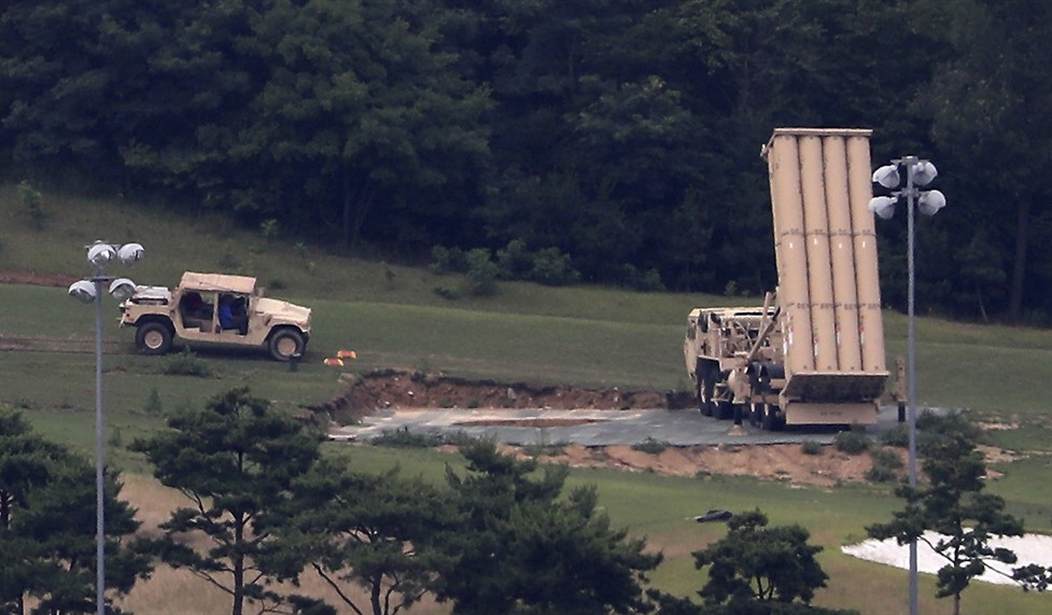Technically, the latest test of the Terminal High Altitude Area Defense (THAAD) system produced a terrific success. Politically and strategically in regard to North Korea, it may not matter much. The US proved again that it could intercept short- and medium-range ballistic missiles, but the game has moved beyond that:
The U.S. on Tuesday test-fired its THAAD anti-ballistic missile system from Alaska that successfully intercepted a target missile launched from an Air Force Cargo plane north of Hawaii.
The drill was previously scheduled in June and comes a week after North Korea successfully test-launched an intermediate-range ballistic missile capable of hitting Alaska.
THAAD is used to intercept short- and intermediate-range ballistic missiles. It does not target intercontinental ballistic missiles. The U.S. has a perfect record on launches, hitting 14 out of 14 targets.
Unfortunately, the threat to the US from North Korea does not involve short- or medium-range missiles, not any more. Pyongyang’s successful launch of an intercontinental ballistic missile means that THAAD is a secondary defense at best. Its real value to American homeland security is the pressure it puts on China to do something about its client Kim regime. The somewhat unexpected embrace of the THAAD system by new South Korean president Moon Jae-in pushes that ball back into Beijing’s court, but it’s not the success of the missile intercepts that bother the Xi government as much as the THAAD radar system.
The US Senate wants more action from the Trump administration after North Korea’s successful ICBM launch. Roll Call reports today on a bipartisan bill that will up the ante on sanctions that target their financial partners:
Senators from both sides of the aisle are hoping to move quickly on legislation that would put further economic pressure on North Korea in the aftermath of the country’s first successful launch of a long-range ballistic missile.
The bills, which would, among other things, impose additional economic sanctions on financial institutions that do business with the regime, are the latest in a line of major foreign policy matters before the chamber in the early tenure of a president that largely lacks the traditional diplomatic experience of past administrations. …
Sens. Patrick J. Toomey, R-Pa., and Chris Van Hollen, D-Md., are crafting legislation that would prohibit entities that do business with North Korea from accessing the U.S. financial system. It is modeled after an Iran sanctions bill that the chamber passed last month but is currently stalled in the House.
That refers to the SWIFT network, which gives financial institutions a reliable platform for safe international transactions. Firms doing business with Iran and Iran itself spent four years frozen out of SWIFT until Barack Obama lifted sanctions in February 2016, and the US has used SWIFT to track terrorist financing since at least the 9/11 attacks. It’s curious that the US has not yet played the SWIFT card, but that may be because some of our ostensible allies would get hit hard by those sanctions. One of them, Malaysia, has since cut off North Korea after the bizarre use of a chemical weapon to assassinate the despot’s older brother in their Kuala Lumpur airport, so perhaps the timing is more propitious now.
What other options do we have? Austin Bay runs down six of them, while noting that none of them are particularly good. The threat is real, though, and has been for some time:
Parts of Alaska (western Aleutians) have been within range of North Korean missiles for several years. So has Guam. There is an ongoing debate about the Taepodong-2 ballistic missile that was test-fired in February 2016. It may have had the range to hit northern California.
The July 4 launch doesn’t mean the North Koreans can handle operational targeting; it doesn’t mean they can mount an operational nuclear warhead on a missile; it doesn’t mean they have a warhead that can re-enter the atmosphere without breaking apart; it doesn’t mean they can detonate a warhead that can reach its target. It does, however, show they are hell bent on acquiring these capabilities and their accelerated development program is succeeding.
For the moment, the heat from North Korea’s intercontinental ballistic missile (ICBM) test remains rhetorical and its fallout political. However, Pyongyang’s nuclear weapons program will eventually produce nuclear warheads for its boosters.
The least bad option is Bay’s first, which entails getting China to act through positive engagement. The surprise endorsement of THAAD by Moon may force Beijing to recalculate, but we’ve been trying this approach for at least two decades, and have little to show for it. Even Option 2, a coercive approach based on trade sanctions on China, might not be enough, but at least it’s the only other option that doesn’t directly lead to a shooting war.







Join the conversation as a VIP Member